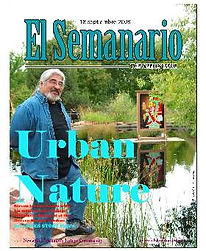top of page
Stevon Lucero
Artist ARchives
Articles 2000's

Denver honors 150 ‘unsung heroes' on sesquicentennial
Stevon Lucero is one of the unsung
by Alan D
Rocky Mountain News ©November 22, 2008
In celebration of its 150th birthday, the City and County of Denver has selected 150 of its citizens to honor as “unsung heroes” – ordinary people who have done extraordinary things to help make Denver a better city for this and future generations. And lists 150 Wonderful Things About Denver.

Urban Nature: A collision of environments
By Cristina Fresquez
Semanario ©8/9/08
The Denver Botanic Gardens brought has found a way to merge the expression of street art with the beauty of nature though their 2008 signature exhibit, “Urban Nature”.
Another local artist selected to display artwork was metarealist artist Stevon Lucero, who has two works on display, “Gift of Corn” and “Scarlet Maiden”, which are located in the Sacred Earth Gardens.

Painting beyond mind, body, soul
by Cristina Frésquez
Published in El Seminario ©January 11, 2007
Local Denver artist, Stevon Lucero, has been creating soul captivating visuals for 40 years, transporting people to his world of visions and enlightened thought. Since childhood, Lucero has experienced intense dreams and visions, venturing more then once into separate realities. Through these revelations and studies of metaphysical, philosophical, and historical books and tapes, he has been guided to create two unique art forms: Metarealism and Neo-Precolumbian art.

Visions on Canvas
by Renee Fajardo ©2006 Read Five Magazine Article Issue 8
“Heaven is before you, but you can not see it. It is obscured by your vision of hell.”
Stevon Lucero is an artist. He has been painting what he sees, hears and experiences for nearly forty years. Five hundred years ago when the Spanish Conquistadors brought their priest to the “New World” (Mexico) where Lucero's ancestors were born, those like him would have been embraced with an open fire pit. That's what you do to heretics. Even by today's standards, Lucero could be considered a very dangerous man. When folks in Denver refer to him as the visionary Chicano artist, they aren't just whistling De Colores .

Stevon Lucero Awakens Universal Consciousness for All
by Renee Fajardo ©2006
Photos by Todd Pierson ©2006
Artist Interviews Magazine August 2006
Lucero, who was born in 1949, grew up in Laramie Wyoming amidst Wild West cowboys and Mexican rail road workers. He lived on the “wrong side of the tracks” where life was marked by poverty, violence and alcoholism. “We were just poor Mexican kids living in a redneck town” laughs Lucero. “I didn't even know I was a Chicano, a Mexican /American, or about my cultural traditions then. I was just trying to survive.”

An Artist of Unique Vision and Perspective
By Don Bain
Published in La Voz ©September 10, 2003
Stevon Lucero has followed the path of a true artist most of his life, over thirty years of it in the metropolis of Denver. He has produced a prolific body of work in three different styles” Neo-Precolumbian, Representational, and Metarealism. Lucero was born and raised in Laramie, Wyoming in a family far removed from the typical Latino experience and community. Asked about his childhood, it becomes apparent he walked an arduous path in early life, but looks back upon it with a philosophical perspective.

Colorado Artist Stevon Lucero
by Miguel Angel Castro
9 News Article ©January 25, 2002
From an early age, Stevon Lucero viewed things in life with a profound sense of spirituality and symbolism.
While growing up in the city of Laramie, Wyoming, Stevon Lucero remembers being very inquisitive and curious about spiritual themes. He began exploring the perception of reality and similar subjects.

A Breakthrough Exhibit at Museo
Renee Fajardo ©2006
Originally published in La Voz
If Chicanos have never left Aztlan, then it is because Atzlan evolved and progressed. In this context, the art in the show begins to take on a new meaning. Lucero's stunning and never before seen modern Aztec codice, Xocotl, perhaps embodies the spirit of the show most perfectly. The piece is about sacrifice and giving of one's self without fear. If we have not left Aztlan it is because we have made certain sacrifices and done so willingly.

Viva Chicano History
By Susan Froyd
Published in Westord ©Thursday, August 5, 2004
Though Lalo wasn't a fine artist, his spirit will certainly fly through the room Friday when the Old Timers..? Show opens at CHAC, now settled as a gallery on Santa Fe Drive, where it long stood alone, preceding the current influx of art venues in the neighborhood. Featuring works by six original CHAC artists -- Ernie Gallegos, Stevon Lucero, Jerry Jaramillo, Al Sanchez, Carlos Sandoval and the late Fred Sanchez -- who are linked together by their participation in a mural project dubbed "City Walls," Old Timers is an art exhibit on the surface, but a slice of history deep inside.

Paint the Town Brown
For these Chicano artists, home is where the art is.
By Harrison Fletcher
Article Published in WESTWORD ©April 24, 2003
At CHAC, artists have tackled everything from AIDS to homelessness. In 1992, Manzanares started the Chile Harvest Festival, which for five years featured traditional colonial art from New Mexico and southern Colorado, including santos, tin work, retablos and weaving. Later, CHAC invited taggers to create aerosol art and featured the Día de los Muertos altars of former gang members. CHAC has displayed everything from ironing-board saints to velvet Elvis paintings, from grandmas' pot holders to erotica exhibitions.
bottom of page